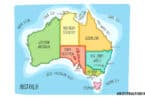Australia’s history as a penal colony is a defining chapter in the nation’s story, and for many Australians, it’s where their family history begins. The transportation of convicts to Australia, beginning in 1788 and continuing for eighty years, created a wealth of records that are invaluable to genealogists today. These records not only provide details about the individuals who were transported but also offer insights into the social and legal context of the time.
Understanding Convict Transportation to Australia
Over one hundred sixty thousand men, women, and children were transported to Australia from Britain and Ireland between 1788 and 1868. These individuals were sent to serve sentences for crimes ranging from petty theft to political dissent. The British government meticulously recorded the details of each convict, creating a rich archive that is still accessible to this day.
The transportation system was intended as punishment and a means of populating the new colonies. Convicts were assigned to work for free settlers or the government, and many became settlers themselves after serving their sentences. This makes convict records an essential starting point for anyone tracing their Australian ancestry.
Accessing and Interpreting Convict Records
Convict records are among the most accessible and detailed genealogical resources available for Australian research. They typically include the convict’s name, age, place of birth, crime, sentence, and details about their transportation, such as the ship’s name and the date of arrival in Australia.
When examining convict records, it’s important to consider the broader context. The records often include information on the convict’s behavior during their sentence, such as punishments for infractions or rewards for good conduct. They may also provide clues about their life after release, such as land grants or marriages.
Here are some key resources where you can find convict records and related information:
The New South Wales State Archives
Holds extensive convict records, including transportation registers, assignment lists, and pardons. Many of these records are digitized and available online at records.
Provides access to a comprehensive collection of convict records, including convict conduct registers, indent records, and muster rolls. These can be accessed online through their website.
The National Archives in the UK
Holds records of the original trials, transportation orders, and other documents about convicts sent to Australia. Some records are available online; others can be accessed by visiting the archive or requesting copies.
Ancestry
Offers a vast collection of Australian convict records, including transportation registers, convict musters, and related documents. This is a subscription service, but many libraries offer free access.
Findmypast
Also hosts a large database of convict records, including trial records, transportation registers, and convict petitions. This platform requires a subscription, but free access may be available through local libraries.
Is a dedicated website that allows users to search for information about convicts transported to Australia, offering free access to a range of records, including trial details and transportation information.
Female Convicts Research Centre
This resource, which specializes in the history of female convicts, provides access to records, research guides, and a community of researchers focused on women transported to Australia.
The Legacy of Convicts in Australian Society
For many Australians, discovering convict ancestry is a point of pride, reflecting resilience and survival against the odds. Convict records can reveal fascinating stories about individuals who overcame their circumstances to build new lives in a challenging environment. Some convicts went on to become prominent members of society, while others blended into the burgeoning population of settlers.
These records also provide a window into the social and legal systems of the time. The crimes for which people were transported often reflect the harsh realities of life in 18th and 19th Britain, where poverty and social unrest were widespread. Understanding the context in which your ancestors lived can add depth to your genealogical research and help you appreciate the challenges they faced.
Tracing Female Convicts and Their Unique Challenges
Female convicts, while fewer in number, played a crucial role in the development of early Australian society. They were often assigned to domestic service or married to free settlers, sometimes under duress. Their records can be more challenging to trace, as they were often absorbed into the households they served, with fewer details recorded about their lives.
However, there are specialized resources available for researching female convicts. The Female Factory in Parramatta, New South Wales, for example, was one of several institutions where female convicts were housed and put to work. Records from these institutions can provide details about the women’s lives, including the work they performed, their conduct, and their eventual fate.
Case Study: Tracing a Convict Ancestor
Let’s take a look at a hypothetical example of how convict records can be used in genealogical research. Suppose you discover that your ancestor, John Smith, was transported to Australia aboard the First Fleet in 1788. By accessing convict records, you find that he was sentenced to seven years for theft in London.
Further research reveals that John was assigned to work for a free settler in New South Wales and later received a land grant after serving his sentence. Through land records and census data, you trace his movements and discover that he married another former convict, Sarah Jones, and they had several children.
By piecing together these records, you can create a detailed narrative of John and Sarah’s lives, from their criminal convictions in Britain to their roles as early settlers in Australia. This case study demonstrates how convict records can provide the foundation for a rich and engaging family history.
The Importance of Convict Records in Australian Genealogy
Convict records are a vital resource for anyone researching Australian ancestry. They offer a unique glimpse into the lives of the individuals who helped shape the nation, often under the most challenging circumstances. By accessing and interpreting these records, you can uncover the stories of your convict ancestors and gain a deeper understanding of the social and historical context in which they lived.
Whether your ancestor was a notorious criminal or a victim of harsh laws, their story is integral to Australia’s history. By exploring convict records, you learn more about your family’s past and contribute to the broader narrative of Australia’s development as a nation.
Read More
“Australia’s Birthstain: The Startling Legacy of the Convict Era” explores the impact of the convict era on Australia’s development and its effects on society.
“Early Australian History: Convict Life in New South Wales and Van Diemen’s Land” provides a detailed look at the realities of convict life during the early colonial period in Australia.
“The Convict Settlers of Australia” examines the lives of the transported convicts and their contributions to early Australian society.
“Convict Words: The Language of the Australian Convict Era” explores the unique language and expressions that emerged during the convict era in Australia, offering insights into the cultural and social aspects of that time.







